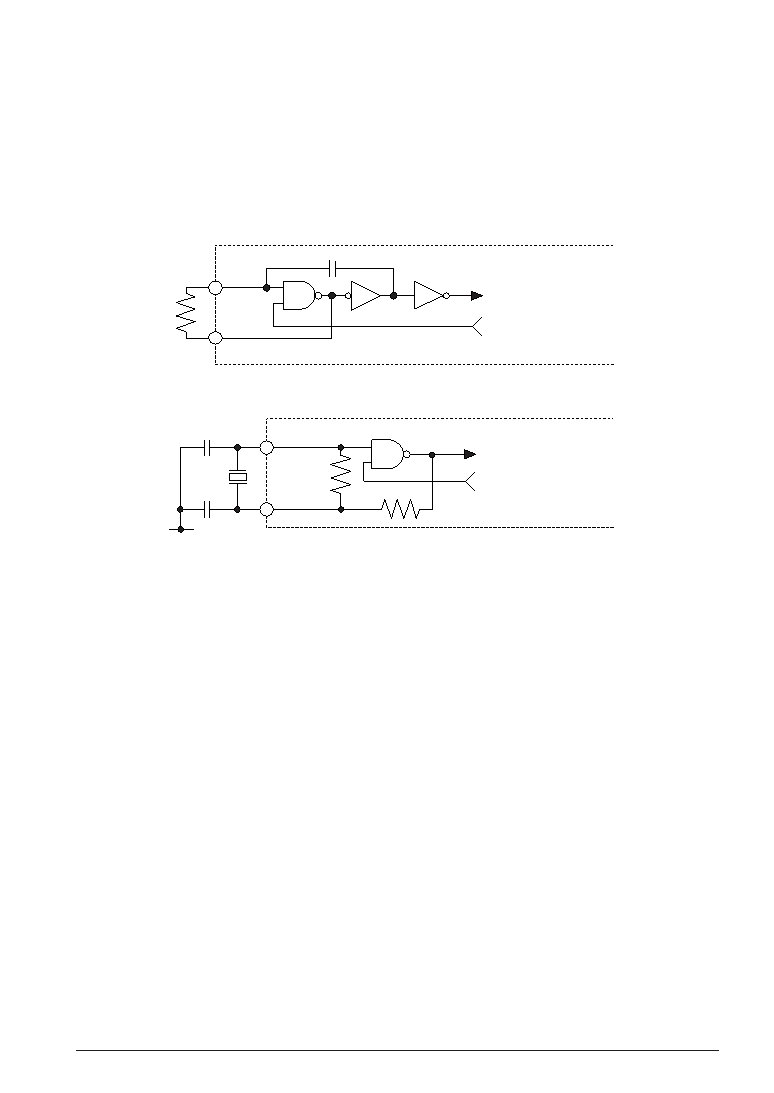- 您現(xiàn)在的位置:買賣IC網(wǎng) > PDF目錄98068 > S1C6P366D0A0100 4-BIT, FLASH, 4.1 MHz, MICROCONTROLLER, UUC102 PDF資料下載
參數(shù)資料
| 型號: | S1C6P366D0A0100 |
| 元件分類: | 微控制器/微處理器 |
| 英文描述: | 4-BIT, FLASH, 4.1 MHz, MICROCONTROLLER, UUC102 |
| 封裝: | DIE-102 |
| 文件頁數(shù): | 27/84頁 |
| 文件大小: | 1740K |
| 代理商: | S1C6P366D0A0100 |
第1頁第2頁第3頁第4頁第5頁第6頁第7頁第8頁第9頁第10頁第11頁第12頁第13頁第14頁第15頁第16頁第17頁第18頁第19頁第20頁第21頁第22頁第23頁第24頁第25頁第26頁當前第27頁第28頁第29頁第30頁第31頁第32頁第33頁第34頁第35頁第36頁第37頁第38頁第39頁第40頁第41頁第42頁第43頁第44頁第45頁第46頁第47頁第48頁第49頁第50頁第51頁第52頁第53頁第54頁第55頁第56頁第57頁第58頁第59頁第60頁第61頁第62頁第63頁第64頁第65頁第66頁第67頁第68頁第69頁第70頁第71頁第72頁第73頁第74頁第75頁第76頁第77頁第78頁第79頁第80頁第81頁第82頁第83頁第84頁

S1C6P366 TECHNICAL MANUAL
EPSON
23
CHAPTER 4: PERIPHERAL CIRCUITS AND OPERATION (Oscillation Circuit)
4.3.3 OSC3 oscillation circuit
The S1C6P366 has built-in the OSC3 oscillation circuit that generates the CPU's sub-clock for high speed
operation and the source clock for peripheral circuits needing a high speed clock (programmable timer,
FOUT output). The mask option enables selection of either the CR (Typ. 1.8 MHz) or ceramic (Max. 4
MHz ceramic oscillation) oscillation circuit. When CR oscillation is selected, only a resistance is required
as an external element. When ceramic oscillation is selected, a ceramic oscillator and two capacitors (gate
and drain capacitance) are required.
Figure 4.3.3.1 is the block diagram of the OSC3 oscillation circuit.
(a) CR oscillation circuit
(b) Ceramic oscillation circuit
Fig. 4.3.3.1 OSC3 oscillation circuit
As shown in Figure 4.3.3.1, the CR oscillation circuit can be configured simply by connecting the resistor
RCR between the OSC3 and OSC4 terminals when CR oscillation is selected. See Chapter 9, "Electrical
Characteristics" for resistance value of RCR.
When ceramic oscillation is selected, the ceramic oscillation circuit can be configured by connecting the
ceramic oscillator (Max. 4 MHz) between the OSC3 and OSC4 terminals, capacitor CGC between the OSC3
and OSC4 terminals, and capacitor CDC between the OSC4 and VSS terminals. For both CGC and CDC,
connect capacitors that are about 100 pF. To reduce current consumption of the OSC3 oscillation circuit,
oscillation can be stopped by the software (OSCC register).
C CR
OSC3
OSC4
R
CR
VSS
CGC
CDC
Ceramic
OSC4
OSC3
R
RDC
FC
To CPU
(and some peripheral circuits)
Oscillation circuit control signal
To CPU
(and some peripheral circuits)
Oscillation circuit control signal
相關(guān)PDF資料 |
PDF描述 |
|---|---|
| S1C6P466D0A0A00 | MICROCONTROLLER, UUC140 |
| S1C6S2L7D | 4-BIT, MROM, 0.032 MHz, MICROCONTROLLER, UUC58 |
| S1C6S2A7F | 4-BIT, MROM, 0.08 MHz, MICROCONTROLLER, PQFP60 |
| S1C6S2B7F | 4-BIT, MROM, 0.08 MHz, MICROCONTROLLER, PQFP60 |
| S1C6S2N7D | 4-BIT, MROM, 0.08 MHz, MICROCONTROLLER, UUC58 |
相關(guān)代理商/技術(shù)參數(shù) |
參數(shù)描述 |
|---|---|
| S1C-6-S | 制造商:GRIPCO 功能描述: |
| S1C7309X | 制造商:SAMSUNG 制造商全稱:Samsung semiconductor 功能描述:B/W CCD PROCESSOR |
| S1C7309X01 | 制造商:SAMSUNG 制造商全稱:Samsung semiconductor 功能描述:B/W CCD PROCESSOR |
| S1C88349 | 制造商:EPSON 制造商全稱:EPSON 功能描述:8-bit Single Chip Microcomputer |
| S1C88649 | 制造商:EPSON 制造商全稱:EPSON 功能描述:8-bit Single Chip Microcomputer |
發(fā)布緊急采購,3分鐘左右您將得到回復。